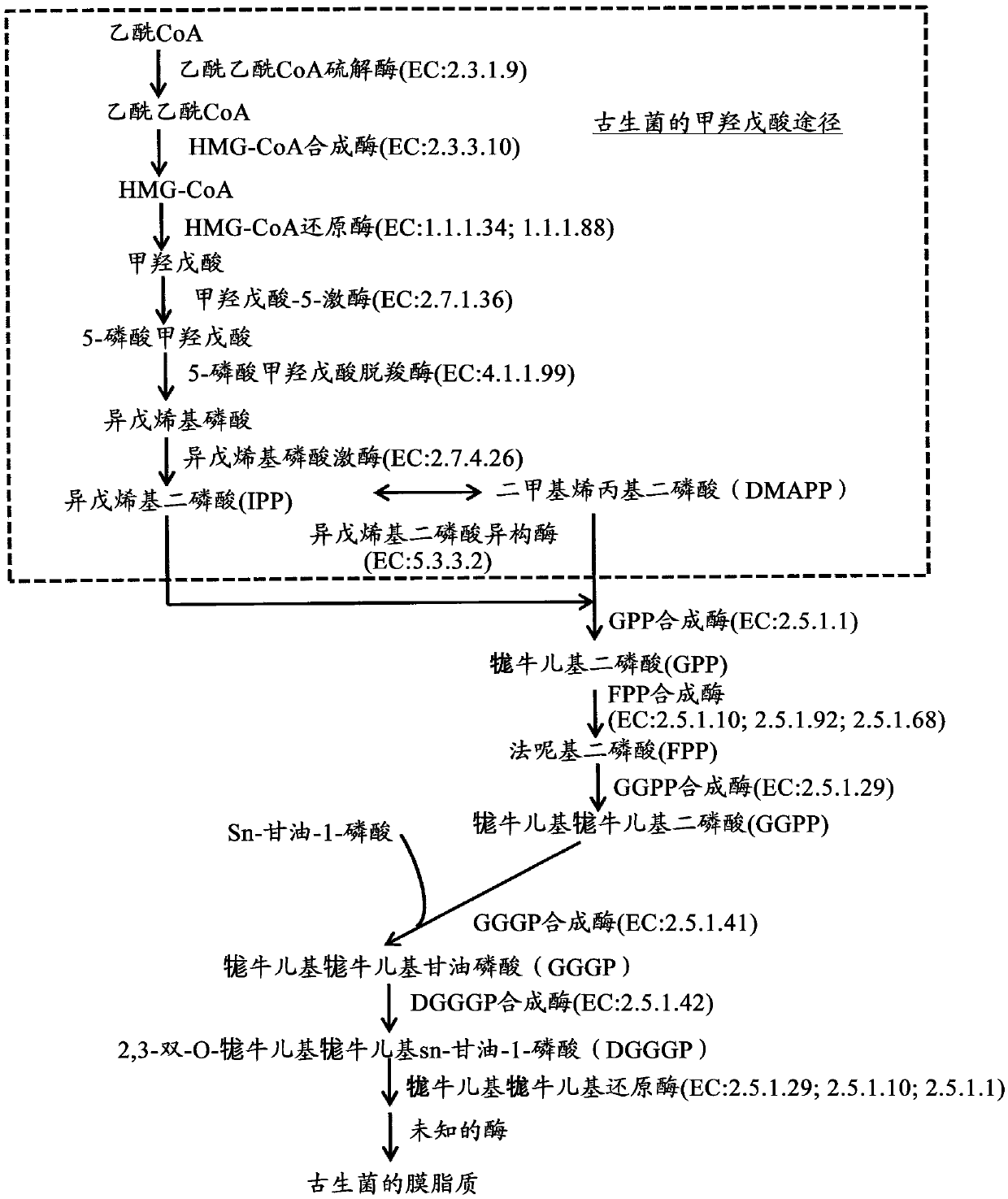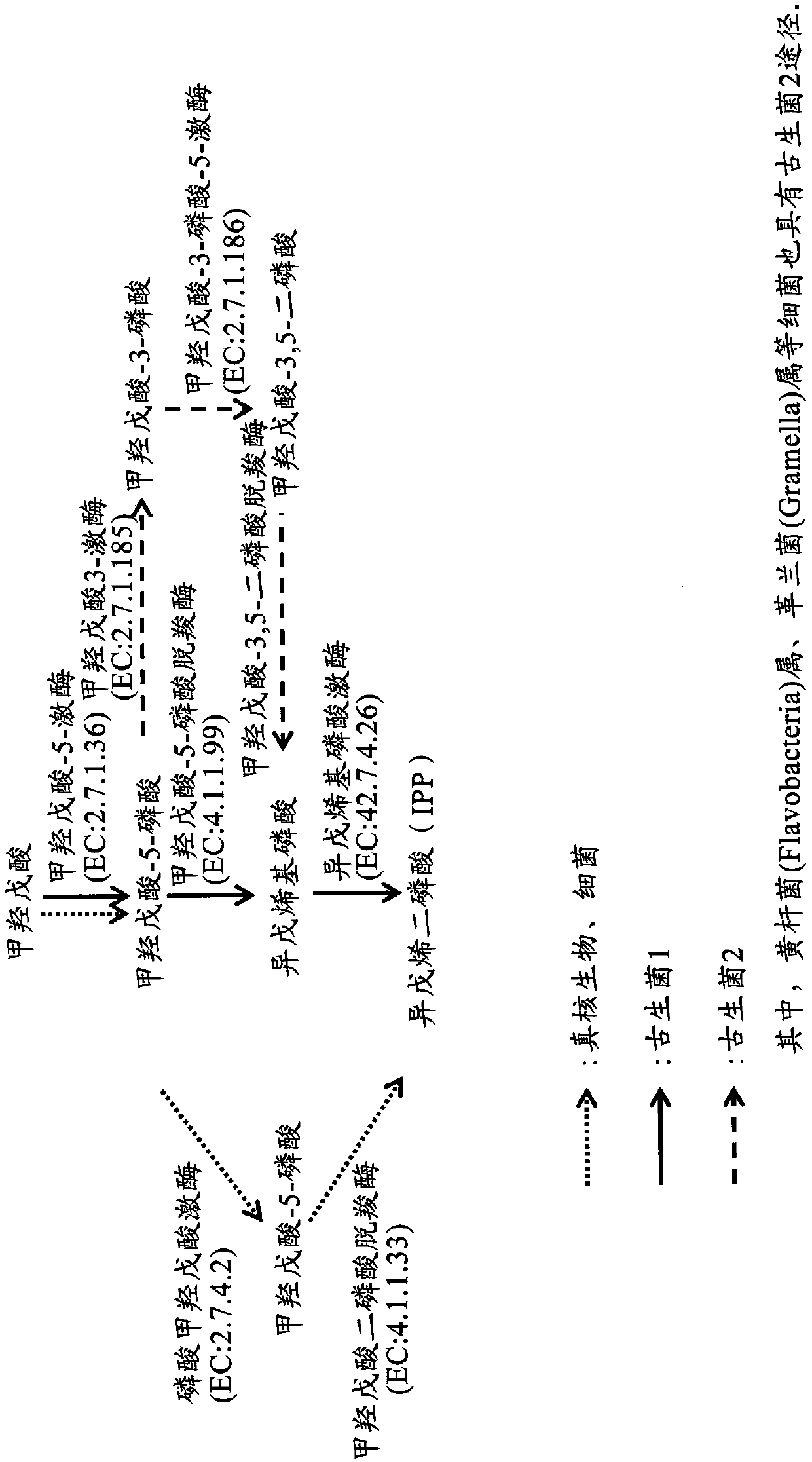Recombinant cells and method for producing isoprene or terpene
A technology for recombining cells and isoprene, which is applied in the field of isoprene or terpene production, and can solve problems such as inappropriate production of isoprene, inability to obtain transformants, and limited supply of raw materials
- Summary
- Abstract
- Description
- Claims
- Application Information
AI Technical Summary
Problems solved by technology
Method used
Image
Examples
Embodiment 1
[0213] Preparation of Isoprene Synthesis Gene Transfer Vectors for Isoprene Production in Archaea
[0214] In this example, prepare as Figure 5 The vector pAC:Pmcr-IDI-IspS for isoprene synthesis in archaea shown in . The vector is a shuttle vector having the replication region contained in the endogenous plasmid of Methanosarcina acetivorans and the replication region p15A in Escherichia coli, and can be derived from Methanococcus voltae The promoter PmcrB (methyl coenzyme M reductase) is used to make the IDI (isopentenyl diphosphate isomerase) gene derived from Saccharomyces cerevisiae and the IspS (isoprene synthase) gene derived from Poplus canescens be constitutively expressed.
[0215] Plasmid pACYC184 (Nippon Gene Co., Ltd.) was digested with HindIII and BclI to obtain a fragment containing the chloramphenicol resistance gene (Cat) and the replication region p15A, and a linker sequence comprising sequence number 5 and sequence number 6 was introduced to obtain Plasmi...
Embodiment 2
[0219] Transformation of Methanosarcina barkeri and production of isoprene from various carbon sources
[0220] According to the method of Metcalf WW et al. (Metcalf WW et al., PNAS 1997, 94, 1997), single-cell culture of Methanosarcina barkeri (DSM800) and preparation of competent cells were carried out. That is, by ATCC 2825 modified medium (wherein 1L contains 10 grams of magnesium chloride hexahydrate, 0.76 grams of potassium chloride, 24 grams of sodium chloride) (pH 6.8), under stringent anaerobic conditions, cultured to Several growth phase (OD600=0.3-0.6). Bacteria were recovered by centrifugation in an anaerobic chamber (Coy). The recovered thalline was suspended in 0.85M sucrose aqueous solution to obtain competent cell suspension (about 10 9 cells / mL).
[0221] 15 μL of DOTAP liposomes (Boehringer Mannheim), 100 μL of 20 mM HEPES-KOH (pH 7.4), and 2 μg of pAC:Pmcr-IDI-IspS (in 50 μL of HEPES-KOH (pH 7.4)) were mixed, A 15 minute incubation was performed. Add 1 ...
Embodiment 3
[0232] Preparation of vectors for farnesene production in archaea
[0233] In this example, the carrier pAC:Pmcr-IDI-FnS ( Figure 6 ) and pAC:Pmcr-IDI-FnS-FPS ( Figure 7 ). pAC:Pmcr-IDI-FnS contains IDI from Saccharomyces cerevisiae and Farnesene synthase (FnS) genes from Artemisia annua. pAC:Pmcr-IDI-FnS-FPS contains the above-mentioned IDI, Saccharomyces cerevisiae-derived farnesene synthase (FPS), and the above-mentioned FnS gene.
[0234] Use MluI-NotI to the pAC prepared in embodiment 1:Pmcr-IDI-IspS ( Figure 5 ) to remove the IDI-IspS region and obtain a linear fragment. The linear fragment was fused with a gene fragment containing IDI-FnS (SEQ ID NO: 11) to construct pAC:Pmcr-IDI-FnS (SEQ ID NO: 13, Figure 6 ). In addition, the linear fragment was fused with a gene fragment containing the IDI-FnS-FPS gene (SEQ ID NO: 12) (Genewiz Company) to construct pAC:Pmcr-IDI-FnS-FPS gene (SEQ ID NO: 14, Figure 7 ). exist Figure 6 and 7Among them, scIDI represents I...
PUM
 Login to View More
Login to View More Abstract
Description
Claims
Application Information
 Login to View More
Login to View More - R&D
- Intellectual Property
- Life Sciences
- Materials
- Tech Scout
- Unparalleled Data Quality
- Higher Quality Content
- 60% Fewer Hallucinations
Browse by: Latest US Patents, China's latest patents, Technical Efficacy Thesaurus, Application Domain, Technology Topic, Popular Technical Reports.
© 2025 PatSnap. All rights reserved.Legal|Privacy policy|Modern Slavery Act Transparency Statement|Sitemap|About US| Contact US: help@patsnap.com



